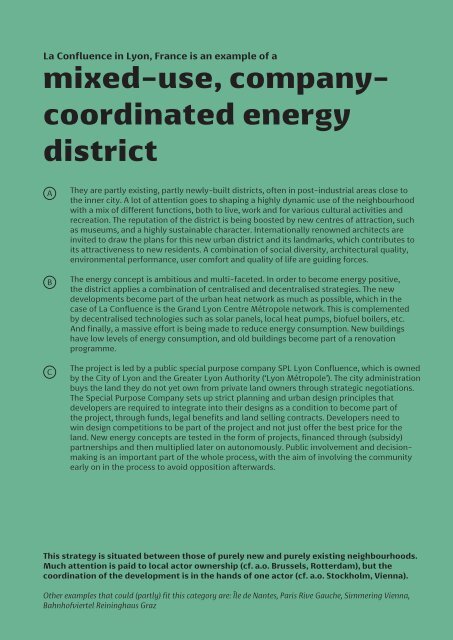Cities4PEDs Atlas_November 2021.pdf
Atlas - From 7 case interviews to recurring strategies and PED relevant aspects
Atlas - From 7 case interviews to recurring strategies and PED relevant aspects
- No tags were found...
Create successful ePaper yourself
Turn your PDF publications into a flip-book with our unique Google optimized e-Paper software.
La Confluence in Lyon, France is an example of a<br />
mixed-use, companycoordinated<br />
energy<br />
district<br />
A<br />
B<br />
C<br />
They are partly existing, partly newly-built districts, often in post-industrial areas close to<br />
the inner city. A lot of attention goes to shaping a highly dynamic use of the neighbourhood<br />
with a mix of different functions, both to live, work and for various cultural activities and<br />
recreation. The reputation of the district is being boosted by new centres of attraction, such<br />
as museums, and a highly sustainable character. Internationally renowned architects are<br />
invited to draw the plans for this new urban district and its landmarks, which contributes to<br />
its attractiveness to new residents. A combination of social diversity, architectural quality,<br />
environmental performance, user comfort and quality of life are guiding forces.<br />
The energy concept is ambitious and multi-faceted. In order to become energy positive,<br />
the district applies a combination of centralised and decentralised strategies. The new<br />
developments become part of the urban heat network as much as possible, which in the<br />
case of La Confluence is the Grand Lyon Centre Métropole network. This is complemented<br />
by decentralised technologies such as solar panels, local heat pumps, biofuel boilers, etc.<br />
And finally, a massive effort is being made to reduce energy consumption. New buildings<br />
have low levels of energy consumption, and old buildings become part of a renovation<br />
programme.<br />
The project is led by a public special purpose company SPL Lyon Confluence, which is owned<br />
by the City of Lyon and the Greater Lyon Authority (‘Lyon Métropole’). The city administration<br />
buys the land they do not yet own from private land owners through strategic negotiations.<br />
The Special Purpose Company sets up strict planning and urban design principles that<br />
developers are required to integrate into their designs as a condition to become part of<br />
the project, through funds, legal benefits and land selling contracts. Developers need to<br />
win design competitions to be part of the project and not just offer the best price for the<br />
land. New energy concepts are tested in the form of projects, financed through (subsidy)<br />
partnerships and then multiplied later on autonomously. Public involvement and decisionmaking<br />
is an important part of the whole process, with the aim of involving the community<br />
early on in the process to avoid opposition afterwards.<br />
Working document<br />
This strategy is situated between those of purely new and purely existing neighbourhoods.<br />
Much attention is paid to local actor ownership (cf. a.o. Brussels, Rotterdam), but the<br />
coordination of the development is in the hands of one actor (cf. a.o. Stockholm, Vienna).<br />
Other examples that could (partly) fit this category are: Île de Nantes, Paris Rive Gauche, Simmering Vienna,<br />
Bahnhofviertel Reininghaus Graz<br />
35


















